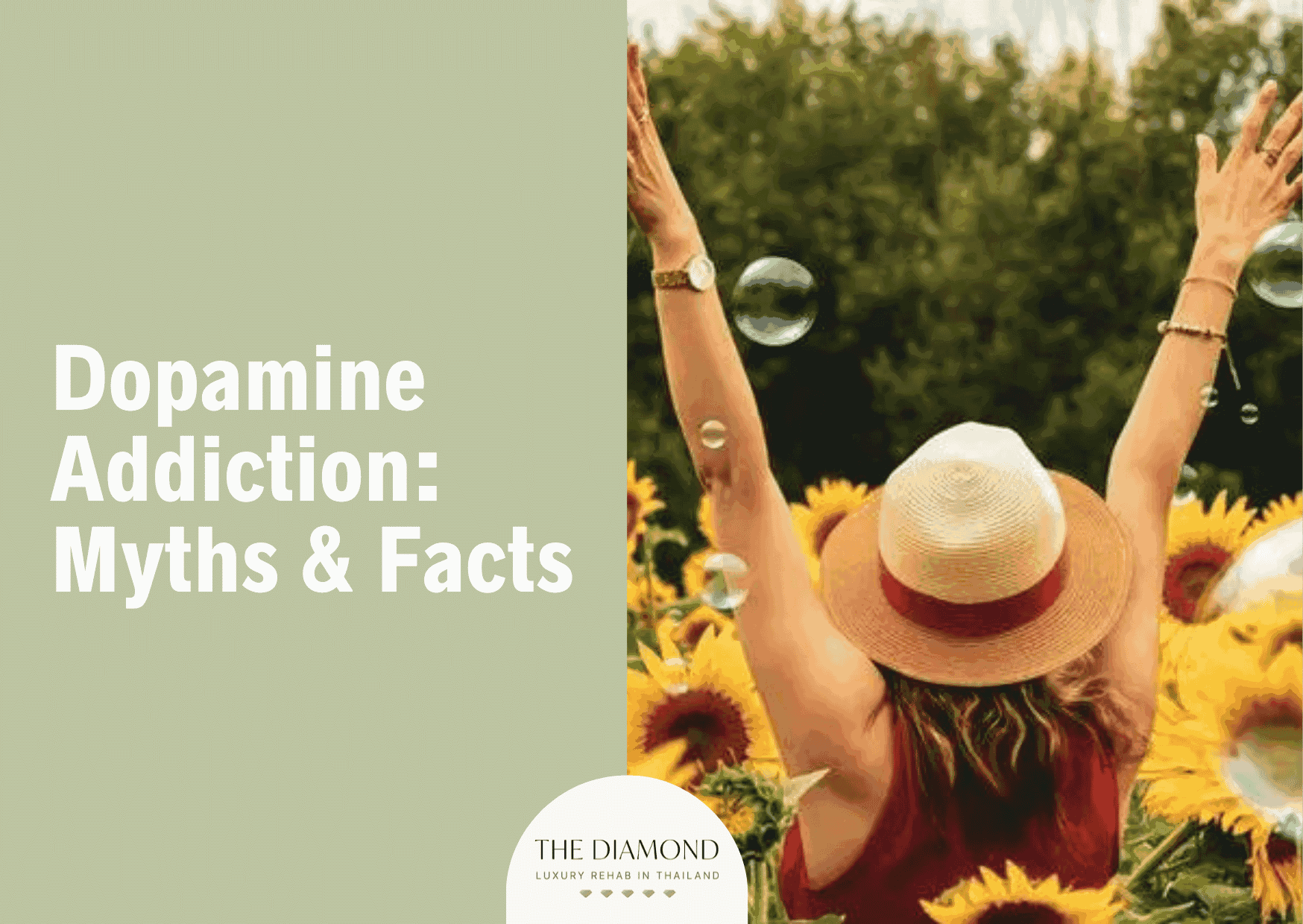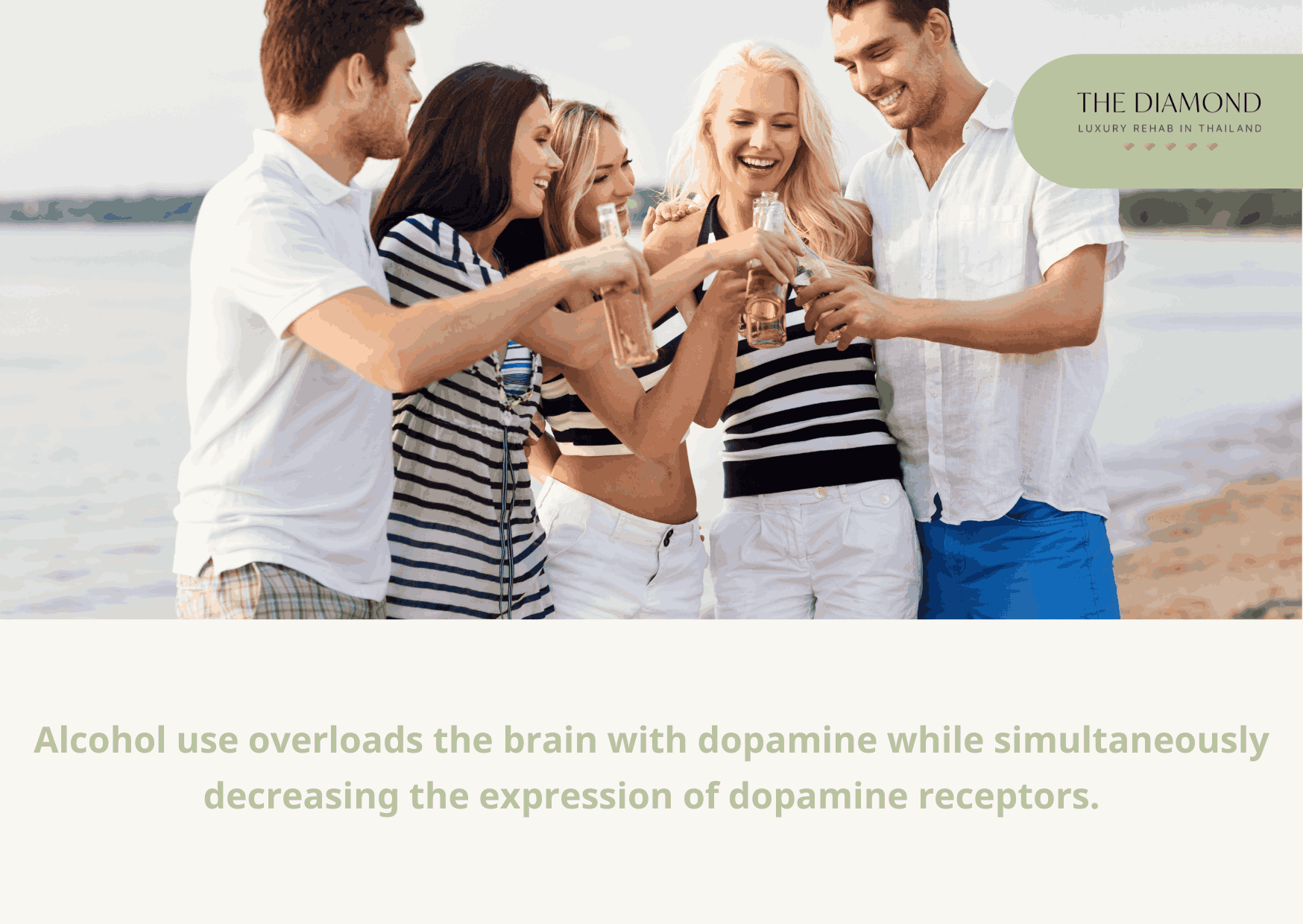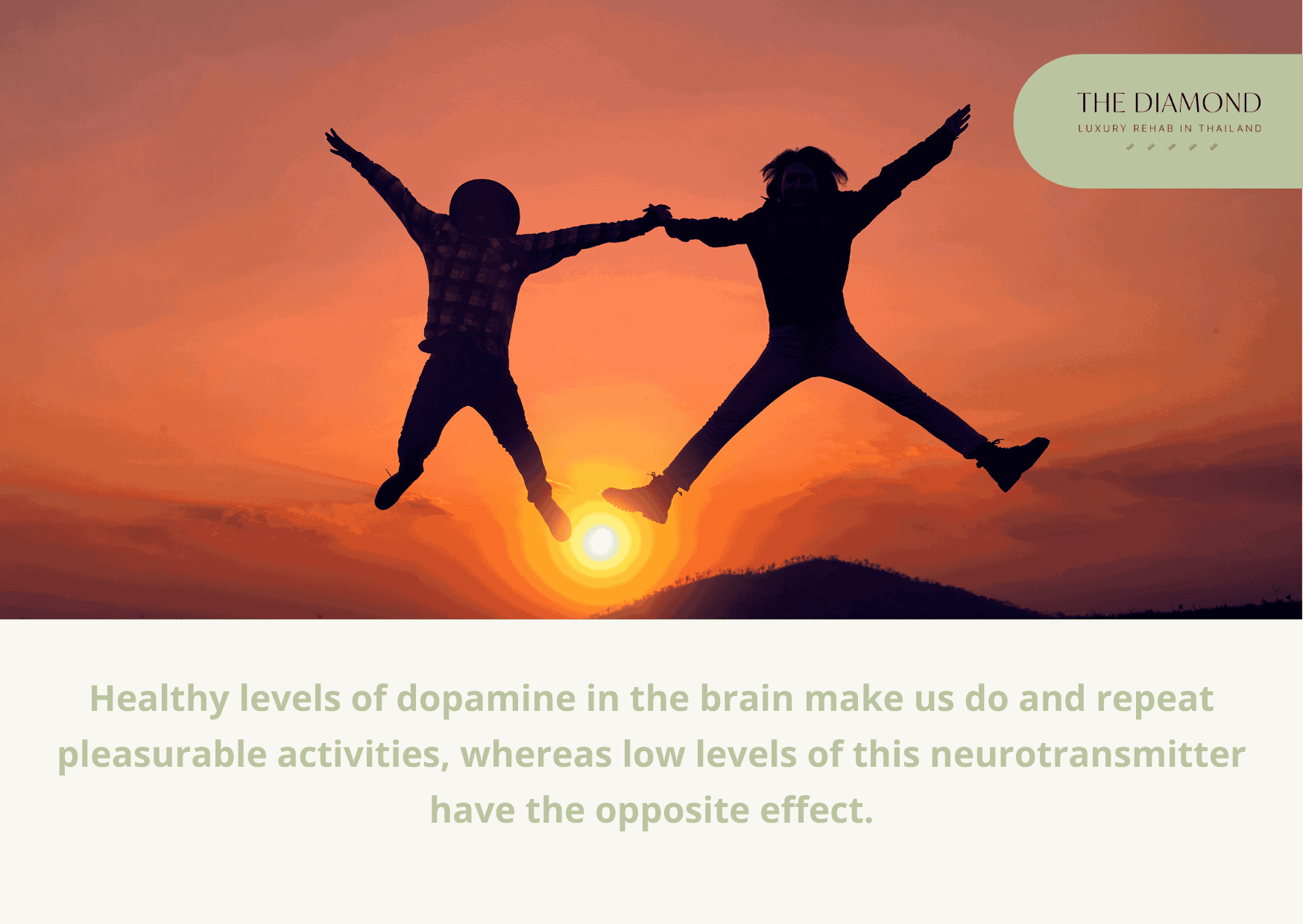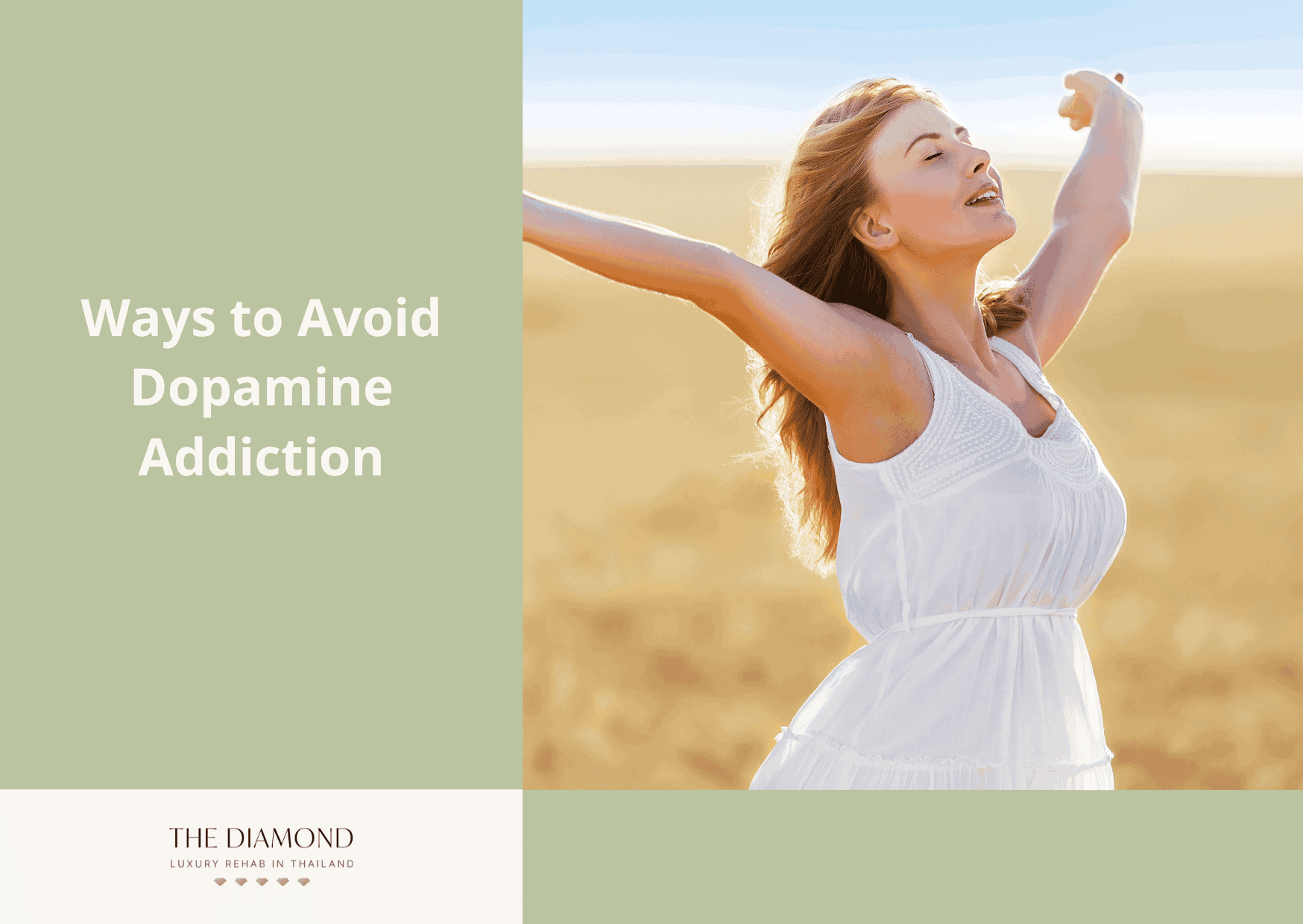Dopamine addiction: myths and facts

Dopamine addiction is a term that refers to being addicted to substances or activities that boost the release of dopamine neurotransmitters.
The main causes of dopamine addiction are a combination of biological and environmental influences. A person’s genetics, age, and gender play a role in the development of addiction. Risk factors also influence the history of other health problems and socializing with persons who are addicted.
The main symptoms of dopamine addiction include using the substance or engaging in certain behavior despite negative consequences, and repeated failures in attempts to stop engaging in the addictive behaviors.
The main misconception about dopamine addiction is that a person is addicted to the neurotransmitter itself instead of to the addictive agent behind the release of dopamine. Fortunately, dopamine addiction is manageable, and persons can achieve successful recovery.
What is dopamine?
Dopamine is a neurotransmitter released when the brain is expecting a reward. This neurotransmitter regulates motivation, motor functions, and reward-associated learning. Dopamine is also involved in many other functions such as digestion, blood flow, heart and kidney function, pain processing, sleep, and stress response.
Healthy levels of dopamine in the brain make us do and repeat pleasurable activities, whereas low levels of this neurotransmitter have the opposite effect.
Even the anticipation of doing a pleasurable activity can stimulate the release of dopamine. For instance, when someone’s comfort food is a specific meal, dopamine levels can increase when they smell that meal baking or see it being taken out of the oven.
When they eat that meal, dopamine levels increase, even more, thus reinforcing the craving and the feeling of satisfaction. In other words, dopamine release involves a cycle of motivation, reward, and reinforcement.
Some activities that prompt the release of dopamine include shopping, exercising, delicious desserts, listening to music, having sex, eating certain foods, and anything else a person might enjoy.
Can you be addicted to dopamine?

You can’t be addicted to dopamine per se, but you can develop an addiction to dopamine-boosting activities. However, the term dopamine addiction refers to the problems when a person becomes addicted to activities or substances that boost the release of dopamine neurotransmitters.
Experiences that make a person feel good activate the reward center in the brain. The reward center responds to the situation by releasing dopamine. The release of this feel-good neurotransmitter urges the brain to pay more attention to that specific activity or experience.
What happens next is that a person develops a strong memory of the pleasure they experienced. As a result, they make more effort to achieve those same feelings again by taking greater amounts of some substances or engaging in addictive behaviors.
A 2020 review on dopamine and addiction published in the Annual Review of Psychology showed that habitual intake of addictive agents decreases the expression of dopamine receptors in the brain. In turn, a person loses interest in other activities they used to enjoy in favor of using the addictive agent or thinking about it.
More precisely, addiction to dopamine is a myth. A person doesn’t take dopamine like pills, food, or alcohol. However, one can develop dependence and later addiction to those activities that give dopamine levels a boost. After all, dopamine is a strong motivator, which plays a major role in the process of developing an addiction.
Yet another myth about dopamine is that it’s a pleasure chemical because the general belief is that dopamine creates a feeling of euphoria. While this neurotransmitter can, indeed, contribute to euphoria and pleasure, it doesn’t induce those feelings. What dopamine does is reinforce enjoyable behaviors and sensations by linking things that make a person feel good with a strong desire to repeat that activity.
A 2021 study on dopamine, behavior, and addiction from the Journal of Biomedical Science explained that dopamine function dictates learned behavior. Addiction is also a learned behavior, to a great extent. When triggered by external stimuli such as addictive agents or some activities, dopamine neurons discharge in bursts and enable a chain of events crucial for learned searching.

What are the risky addiction behaviors associated with dopamine?
Risky addiction behaviors can hijack the dopamine system and cause a person to seek more of the substance or activity. Risky addiction behaviors associated with dopamine are listed below.
- Sex addiction
- Alcohol addiction
- Drug addiction
- Food-related disorders
- Digital addictions
1. Sex addiction
Sex addiction definition is compulsive engagement or participation in sexual activity, with emphasis on sexual intercourse, despite the harmful consequences it causes. For some people, sex addiction can be incredibly dangerous and induce problems in relationships.
Common symptoms associated with sex addiction include chronic and obsessive sexual thoughts and fantasies, lying to cover behaviors, multiple sex partners including strangers, inability to stop or control these behaviors, feeling guilt or remorse after sex, among others.
Orgasm releases dopamine and activates pleasure centers in the brain. For that reason, sex addiction has a lot to do with dopamine release. A person addicted to sex keeps seeking out sexual activities in order to experience the same level of satisfaction. As the expression of dopamine receptors decreases, they need more to maintain that same pleasure. This paves the way to addiction to sex.
A 2008 case report by J Michael Bostwick and Jeffrey A Bucci published in the Mayo Clinic Proceedings confirms that dopamine modulates normal and addictive behavior. Medications that treat alcoholism could be used for the treatment of internet-related sex addiction, but more research on this subject is necessary. The most effective way of treating sex addiction is therapy.
2. Alcohol addiction
Alcohol addiction definition, also known as alcohol use disorder (AUD), is indicated by an impaired ability to control or stop alcohol use despite social, health, or occupational harms and consequences it causes.
According to an article on understanding alcohol use disorder from the National Institute on Alcohol Abuse and Alcoholism, alcohol addiction can be mild, moderate, or severe.
A 2014 paper on the dopamine system and alcohol dependence published in the Shanghai Archives of Psychiatry reports that alcohol intake influences dopamine release in a dose-dependent manner. Amygdala, a part of the brain’s reward circuitry, plays a key role in alcohol-induced effects on a person’s brain.
Basically, alcohol use overloads the brain with dopamine while simultaneously decreasing the expression of dopamine receptors. This explains why alcohol use disorder is considered an activity or problem that falls into the category of dopamine addiction.
The pleasurable effects induced by dopamine boost make a person want to drink more alcohol, but decreased expression of receptors can build tolerance. As a result, a person drinks greater amounts of alcohol continuously to the point they become addicted.
3. Drug addiction
Also known as substance use disorder, drug addiction definition is the inability to control the use of illegal or legal drugs or alcohol even when they harm a person’s health and cause other complications in life.
Drugs and similar substances release dopamine in a more straightforward manner than other activities on this list. Substances such as cocaine directly flood the brain with dopamine.
As a 2013 study by Park et al., from the Journal of Neuroscience reports, chronic cocaine use dampens dopamine signaling, which may lead to even worse compulsive and addictive intake. Decreased signaling leads to the abovementioned problems such as tolerance, dependence, and drug addiction. The same happens with other substances, not just cocaine.
However, as dopamine levels increase, a person is more likely to seek these drugs again in order to experience the same amount of pleasure and excitement.
4. Food-related disorders
Food-related disorders are serious conditions that affect the physical, psychological, and social function of an individual. A person with a food-related disorder is obsessed with food or shape.
These food-related disorders include anorexia nervosa, bulimia nervosa, binge eating disorder, rumination disorder, avoidant or restrictive food intake disorder, among others.
In the context of dopamine addiction, the biggest problem is excessive food intake. Eating is necessary. We need to eat to obtain nutrients from food to help the body function properly so we can stay alive.
Everyone loves delicious foods. In some people, eating is a tool to feel good. They eat food to experience feelings of pleasure and satisfaction. This happens because certain foods increase the release of dopamine in their brain.
A 2010 study on dopamine and binge eating behaviors published in Pharmacology Biochemistry and Behavior confirms dopamine perpetuates the compulsive feeding patterns, while sustained stimulation of dopamine systems can lead to progressive impairments in the signaling of this neurotransmitter.
The problem is the same as those described above; impaired signaling means a person needs greater exposure to achieve the same effects. In this case, the person needs more food, which can lead to disordered eating.
5. Digital addictions
Digital addiction is the compulsive urge to use digital devices, platforms, and technologies obsessively. These include online platforms, video games, music, the internet, gadgets, mobile devices, and social networks. The affected person keeps using these devices and tools despite the harm they cause in their life.
The reward center in a person’s brain releases dopamine in response to satisfactory experience or hyperarousal, as described above in this post. If a person experiences this hyperarousal while playing video games or using social media, the brain will associate that specific activity with dopamine.
As a result, a person develops a strong drive to seek that same pleasure again. In time, this process can lead to digital addiction if dopamine receptors become impaired. That propels a person to intensify their use of mobile phones, the internet, gadgets, and other digital agents just to feel that satisfaction again and again.
What are the risk factors of dopamine addiction?
Risk factors of dopamine addiction are biological (such as age, gender, and genetics) and environmental (choices). In most cases, a combination of the two factors is involved.
Generally speaking, everyone could develop a dopamine addiction. Some people are at a higher risk than others. Addiction is a complicated disorder that develops without an obvious cause. Sometimes it’s difficult to pinpoint a specific cause or risk factor that led to dopamine addiction.
Biological risk factors of dopamine addiction include age, gender, genes, developmental stage, and health history. A 2007 publication on drugs, brains, and behavior from the National Institute on Drug Abuse reports that 40% to 60% of addiction risk is associated with heredity or genetics.
Why? Genes influence different types of receptors in the brain, how quickly the body metabolizes addictive substances, and how well a person responds to medications. Besides genetics, aging can also contribute to addiction. The aging process is indicated by a wide range of psychological, social, and health problems that may lead to substance abuse and other forms of addiction.
Having a health history of certain medical conditions, particularly those associated with mental health, can also increase the risk of dopamine addiction. Different addiction types affect genders differently, so being a man or woman can also make a person more likely to become addicted to a certain substance or behavior.
When it comes to the developmental stage, using drugs in adolescence increases the risk of substance abuse in adulthood. Environmental factors that increase the risk of dopamine addiction include choices a person makes, their home life, and challenges at work or school.
Choosing to socialize with people who engage in risky behaviors or use addictive substances increases the risk of addiction. The same happens when a person lives in a household where family members misuse medications or are addicted to some substances.
Having problems at work or school may also lead to increased dopamine addiction risk. For some people, it’s an escape from problems, while others may opt to use some substances to improve their performance.
What are the ways to avoid dopamine addiction?

Ways to avoid dopamine addiction revolve primarily about setting boundaries, being mindful, and getting enough rest.
Dopamine itself is not bad; we need it for emotions and to feel good. That being said, it’s crucial to avoid becoming addicted to the release of this neurotransmitter. For some people, there is a fine line between enjoying something and becoming addicted to it, as seen in the section above.
The first and most important prevention strategy is to set rules or boundaries. For instance, if a person enjoys sex and notices their libido and sexual practices are harming their quality of life, it’s useful to set limits. These limits could be the number of times they have sex during the week or reducing exposure to triggers such as porn.
Besides setting up the boundary, it’s practical to consult a therapist regarding this subject, or any other professional, e.g., a nutritionist, if a person limits food intake or tries to regulate eating behavior through boundaries.
Some people may find it tricky to stick to the boundaries. Journaling helps to stick to these rules and describe how a person feels every day. Sending an email to oneself can do the trick, as well.
In addition to journaling, getting enough relaxation is also useful for avoiding dopamine addiction. When a person is well-rested and relaxed, they may be less likely to want to engage in dopamine-boosting activities.
Practical activities that calm nerves include meditation, yoga, reading, writing, and other self-care practices, as well as deep breathing. A 2017 study on the effect of diaphragmatic breathing on attention, negative affect and stress in Healthy Adults from the Frontiers in Psychology found that deep breathing can increase attention, lower the levels of the stress hormone cortisol, and improve mental function.
Mindfulness is all about being present in the morning in order to avoid overthinking or focusing on negative thought patterns and behaviors. Mindfulness and meditation go hand in hand. How does it help avoid dopamine addiction? Mindfulness makes a person more aware of what they do and thereby enables them to adopt more positive habits and choices.
The abovementioned deep breathing practice is also a good way to practice mindfulness. Being mindful allows a person to control their behavior more effectively; it also helps an individual assess how they feel at any point in time.
Practicing mindfulness regularly is useful, but also make sure to check in with oneself to ensure whether a person is feeling calm, not “high,” or “excited.” The person who practices mindfulness should also question themselves regarding their concerns and thoughts associated with the activity they could be dependent on.
Regular counseling sessions with a therapist can help stop dopamine addiction. Therapy is not just for individuals who have a problem but also for those who could develop one. Friends and family members may want to encourage the affected person to seek help if they notice problems in their behavior.
Is rehab effective to prevent dopamine addiction?

Rehab is effective for the prevention of dopamine addiction and its treatment. According to a 2004 comparative study by Greenfield et al., published in The American Journal of Drug and Alcohol Abuse, rehab treatment with emphasis on residential treatment is an effective approach to the treatment of substance abuse. The longer the program, the better the effects are.
The main purpose of rehabilitation centers is to provide a safe environment where patients will work on their recovery. The exact form of treatment depends on the specific type of addiction, but it usually includes therapy sessions such as cognitive-behavioral therapy (CBT) and motivational interviewing.
Medications are also prescribed in order to reduce withdrawal symptoms in some addiction types but also to manage underlying mental health problems in some people.
Rehab centers offer inpatient and outpatient treatments. Inpatient or residential treatment requires a patient to spend 60 to 90 days in the program. On the other hand, outpatient treatment doesn’t require a person to sleep in the treatment facility, but it’s necessary to attend regular therapy sessions.
The exact approach varies from one patient to another, depending on the severity of the addiction. Outpatient treatment is usually for persons with mild addiction or those who have completed inpatient treatment. Inpatient treatment is for patients with moderate to severe addiction.
In addition to being a safe environment for breaking the dopamine addiction cycle, rehab centers have other benefits too. These include healthcare professionals specialized in treating addiction and with extensive experience in this field. Patients also get to focus on recovery and explore underlying issues that trigger substance abuse or dopamine addiction. Peer support is also a major aspect of treatment in rehab centers.

